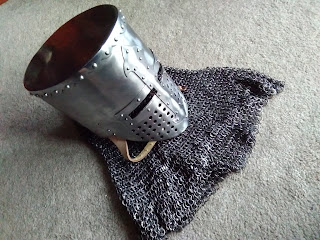12th Century Enclosed Helmet
Picked up a primitive great helm otherwise known as an enclosed helmet to add to my medieval armory collection. Produced by GDFB ( Get Dressed For Battle) the familiar flat top crusader style helmet is made of 14 gauge steel, lined with a leather suspension system, weighs in at about eight pounds and is WMA authorized for combat sport.
The enclosed helmet first appeared around the end of the 12th century after Norman nasal helms began to evolve with added face protection and a square profile. In retrospect the cylinder flat top profile seems counter intuitive and a step back from the conical deflective properties of spangenhelms but became the dominant helmet design of the high middle ages with sugar loaf and great helm versions being used into the 14th century.
Typically worn with a padded cap and chainmail coif the enclosed helmet was probably developed in response to the use of heavy lances by armored knights and massed archers upon the medieval battlefield. Often they were discarded once in a melee due to restrictive peripheral vision and lack of ventilation. That said the tight fit of the helm does place the wearer's eyes quite close to the vision slots which results in surprisingly decent sight lines. The ventilation holes also aids in downward vision. In later variants of the great helm often secret helmets or cerve!lieres were used with mail coifs for head protection once the great helm was removed after the initial cavalry engagement. The biggest issue may well be the lack of hearing and the prodigious weight of the cap, mail coif and helmet ensemble. Medieval knights must have been quite fit, strong and well muscled to function effectively on the battlefield.
Used by famous martial orders such as the Templars, Hospitallers and Teutonic Knights and, of course, recognizable as the black knight's helmet of choice in Monty Python's satire Quest For The Holy Grail the flat top helmet became an iconic symbol of the middle ages.
The enclosed helmet first appeared around the end of the 12th century after Norman nasal helms began to evolve with added face protection and a square profile. In retrospect the cylinder flat top profile seems counter intuitive and a step back from the conical deflective properties of spangenhelms but became the dominant helmet design of the high middle ages with sugar loaf and great helm versions being used into the 14th century.
Typically worn with a padded cap and chainmail coif the enclosed helmet was probably developed in response to the use of heavy lances by armored knights and massed archers upon the medieval battlefield. Often they were discarded once in a melee due to restrictive peripheral vision and lack of ventilation. That said the tight fit of the helm does place the wearer's eyes quite close to the vision slots which results in surprisingly decent sight lines. The ventilation holes also aids in downward vision. In later variants of the great helm often secret helmets or cerve!lieres were used with mail coifs for head protection once the great helm was removed after the initial cavalry engagement. The biggest issue may well be the lack of hearing and the prodigious weight of the cap, mail coif and helmet ensemble. Medieval knights must have been quite fit, strong and well muscled to function effectively on the battlefield.
Used by famous martial orders such as the Templars, Hospitallers and Teutonic Knights and, of course, recognizable as the black knight's helmet of choice in Monty Python's satire Quest For The Holy Grail the flat top helmet became an iconic symbol of the middle ages.





Comments